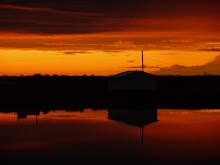Starting with the sun and the tilt of the Earth, oceans produce weather systems, weather systems help to produce climate, and climate determines food supplies available to living things. Food supplies determines what type and how animals and people live.
In our local area that meant people traditionally went where the food was. Permanent, year-round villages did not exist. The people followed the animals. Although the tundra is rich in its own way, many consider it barren. Because of the harsh winds and weather coming from the Bering Sea, the landscape does not support large trees or other plant life. Animals migrate according to the seasons/weather and their own food supplies. The culture was born around the need to survive in a harsh environment. Most of the food comes directly from the sea: seals, whales, and fish. The few plants harvested from the area are greatly affected by the nearby sea. Tundra Tea (also known as Labrador Tea) plant has small leaves and grows close to the ground. My understanding is that in other parts of Alaska it grows much bigger. Some of those places are along the same lines of latitude. It is the same with the different berry plants. They are small here but larger elsewhere. Without the support of the sea, people could not survive here but it is also the weather coming in from the sea that makes it difficult.
“What cultural resources exist where you are? What do long-time residents have to say about climate/ocean dynamics?”
When I first arrived in the area I heard people tell of what many of the Elders were saying. “If the younger generation does not learn to live with the land they will starve.” Once when visiting Bethel I met a very elderly Elder. He said the same thing. A time would come when people would starve if they did not learn. Are they not correct? Whether or not you lean toward the Native ways of knowing or the scientific, if we cannot learn to live on our planet with sustainable practices will any culture survive? The Elders are a culture resource that is fast disappearing.
I have heard, too, that people are having a harder time “reading” the ice. This makes hunting and traveling a very dangerous thing. If the ice is misread then it could be death. Earlier this school year my students read a news article about a boy who had been out hunting on the ice in Hudson Bay with his older relative. The ice started to break. The boy was separated from his relative on an ice flow with three polar bears. Luckily the boy survived. This is rather a dramatic tale of what can happen unexpectedly when the conditions change.
“How useful are simple labs and/or YouTube for your professional purposes?”
In teaching an ESL fourth grade class, simple labs and videos, such as found on TD, are invaluable in teaching concepts to my students. Not only are the visual aspects great for teaching concepts, but also with 100% of my students being ESL telling them about something doesn’t always mean that they are learning or understanding the words. My students are part of an emersion program. The fourth grade year is only the second year of English at our school. My students have enquiring minds and their English vocabulary is still growing. Being able to show a concept is more important than just lecturing about it. Words are puzzles they are still figuring out but examples can be universal to any language.
Subscribe to:
Post Comments (Atom)


Very thoughtful and thorough discussion. The story of the boy trapped on the ice hooked me for sure.
ReplyDelete